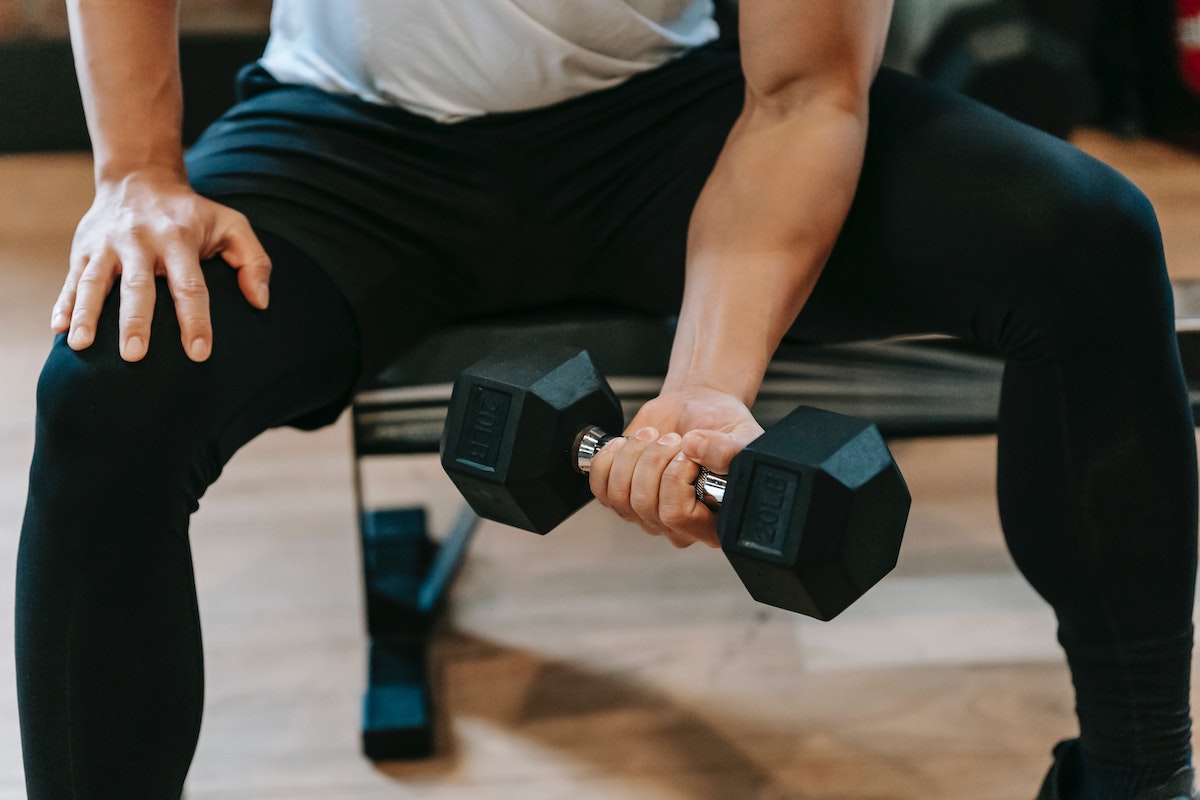Most people include the bicep curl in their workout routine to ramp up muscle growth in the biceps. The bicep curl is a classic, popular, and simple exercise you can do at home or in the gym. The concentration curl is another variation that can mix up your routine and provide several benefits, such as more emphasis on the short head of your biceps and a stronger contraction of the peak of the bicep muscle. Here’s what you need to know to master the concentration curl.
What are concentration curls?

The concentration curl is an isolation exercise and a variation of the bicep curl that’s typically performed using one dumbbell in a seated position on a bench. You support the elbow of your working arm against the inside of your leg for stability. Most people work one arm at a time.
Bracing your working arm against your inner thigh helps limit the involvement of other muscles when you perform this exercise, allowing you to better ‘concentrate’ on your biceps and experience a stronger contraction of the peak of your bicep muscle.
What are the muscles worked?

Concentration curls activate the long and short head of your biceps brachii muscles as well as your:
- Brachialis elbow flexor
- Brachioradialis forearm muscle
- Forearm flexors
- Slight activation of your shoulder muscles from leaning forward
What are the benefits of concentration curls?

One of the main reasons weightlifters perform concentration curls is because they fully isolate and ‘concentrate’ on the biceps more effectively than other curl variations. During the traditional bicep curl, your shoulders or momentum can assist with the lift, but during the concentration curl, you’re forced to move only your elbow joint, which emphasizes muscle contraction.
The following are some of the many benefits of concentration curls:
- Focus on form and experience the full muscle contraction.
- Target the peak of your bicep muscles.
- Work on one arm at a time.
- All you need is a single dumbbell and a bench if you’d like to perform the seated variation.
- Zone in on the form and mechanics of the curl.
- Enhance your strength and see serious gains over time.
- Enhance your overall athletic performance.
- Increase muscle definition for a more sculpted physique.
How to do the concentration curl

Here’s how to do the concentration curl:
- Sit on a bench and hold a dumbbell in one hand between your legs with your arm extended straight down to the floor.
- You should be leaning forward slightly, and the elbow of your working arm should rest against your thigh in the starting position to help keep your arm at a right angle to the ground.
- Engage your core and your shoulder blades.
- Make a fist with your other hand or rest your other hand on your knee.
- Carefully curl the weight up towards your chest and emphasize the squeeze at the top of the movement.
- Return the weight back to the starting position.
- Repeat until you complete the set.
Tips for proper technique

These top tips will help you improve your technique so you can master the concentration curl and bulk up those biceps:
- Avoid ‘locking’ your elbow out at the bottom of the lift.
- Try to make sure your shoulders and torso are in the proper position.
- Engage your core throughout the movement.
- Focus on control and try to keep your wrist in a neutral position.
- Use a weight that allows you to complete the full range of motion.
- Try to make sure your upper arm is perpendicular to the ground throughout the exercise.
- Start with lighter weights and work your way up when you’re ready.
Having proper form helps prevent injuries like elbow tendonitis.
FAQs

Are concentration curls better than bicep curls?
Both concentration curls and bicep curls are effective exercises. Bracing your arm on your inner thigh means you’re forced to move only your elbow joint. Some people find concentration curls are harder, so choosing the right weight is key. Both exercises will enhance your muscle strength and size if you stick with it, but the concentration curl is more effective when it comes to activating and isolating the biceps brachii.
If you’re looking to choose just one, that mostly depends on your goals. If your goal is to emphasize the short head of the biceps, go for the concentration curl. If you want to target the long and short head more evenly, go for the bicep curl. If you want to work both arms at the same time and lift heavier weights, the bicep curl might also be the better choice.
Do concentration curls work all heads?
The concentration curl does work the two heads of your bicep muscle, with the short bicep head being the primary target. The long head isn’t completely stretched with the concentration curl, allowing for better isolation of the short head, which contributes to thicker-looking arms.

How many concentration curls should you do?
How many concentration curls you should do depends on your fitness level and goals. Generally speaking, you can aim for three to six sets of 8-12 reps.
Are concentration curls effective for building bigger biceps?
Concentration curls are superior for building bigger arms and targeting both heads of your bicep muscles. You’ll work your biceps and forearms and improve your grip. This exercise might feel more challenging than other bicep curl variations because momentum is eliminated, and support from other muscles is minimized when you rest your arm on your inner thigh, leaving your bicep to do the heavy lifting.




